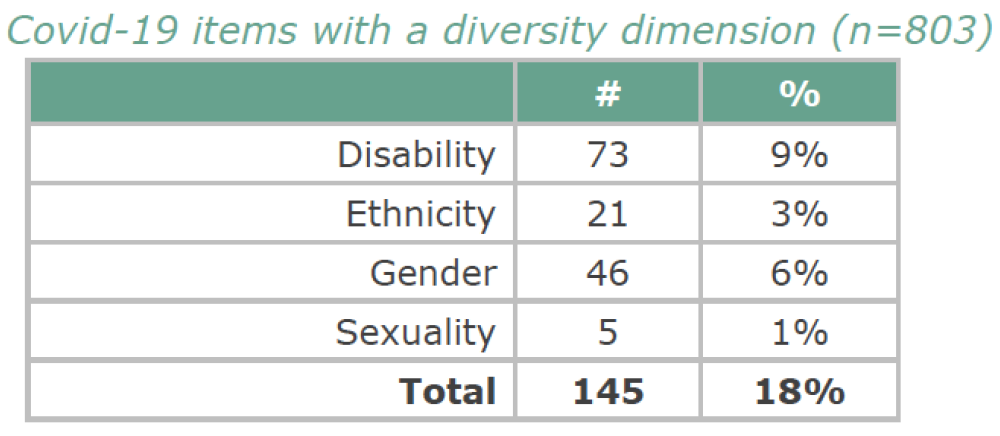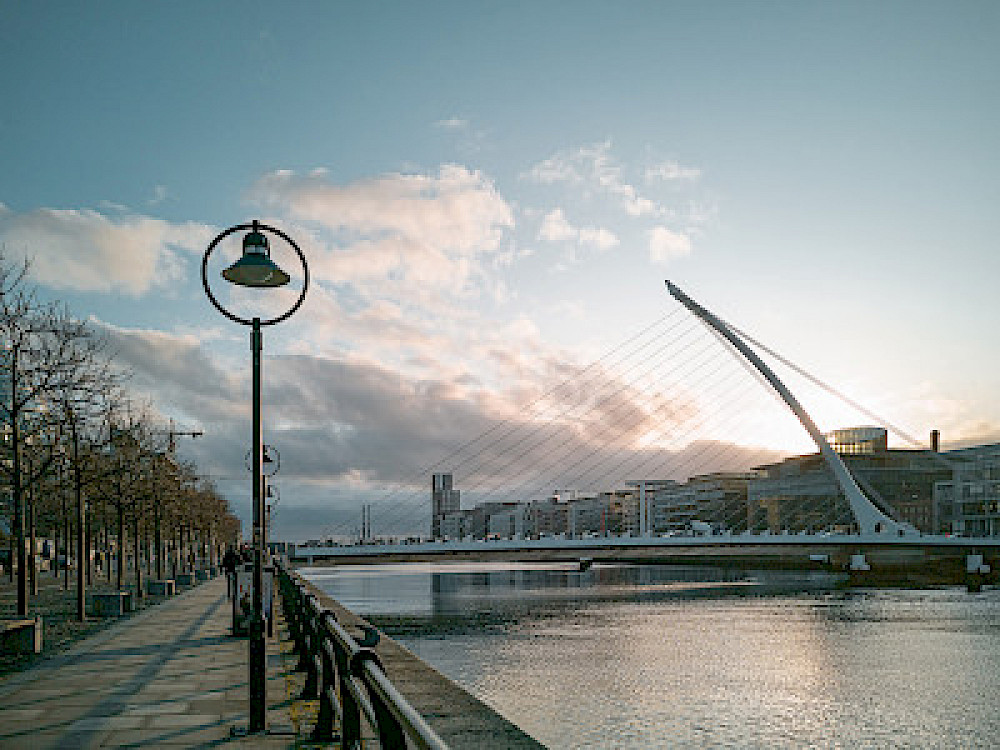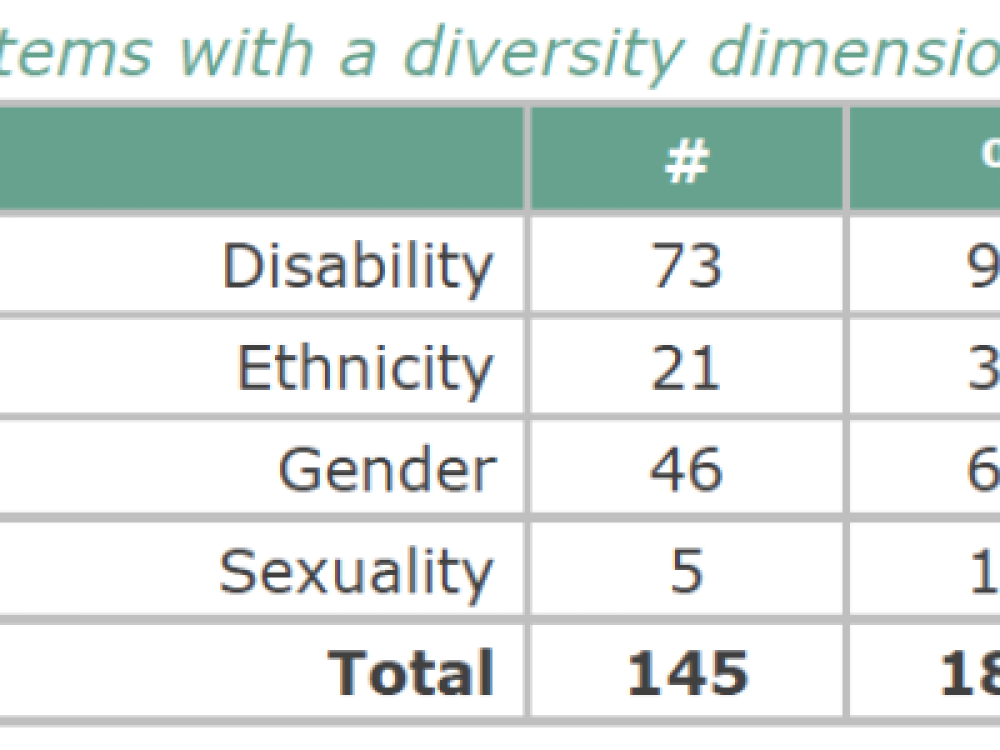A FuJo report examining diversity and inclusion at RTÉ will be launched in a webinar hosted by the Broadcasting Authority of Ireland (BAI). The research, entitled ‘RTÉ and COVID-19 - Diversity and Inclusion and meeting public needs’ was conducted by FuJo's Dr Eileen Culloty and Dr Colm Kearns with the co-operation of RTÉ’s Diversity and Inclusion lead, Dr Zbyszek Zalinski.
Conceived prior to the pandemic, the research aimed to provide baseline knowledge about the diversity of RTÉ’s staff and programme guests and to deliver insights into diversity measurement and data gathering. With the disruption caused by COVID-19, the focus shifted to the crisis. Through interviews and a content analysis, the researchers investigated the gender diversity of programme participants during the first three months of the crisis - between 1 st March and 31 st May 2020 - and how diversity and inclusion is conceptualised by ten RTÉ decision makers.
Content analysis
The content analysis examined six programmes: three Radio 1 programmes (Brendan O’Connor, The Business, and Today) and three RTÉ One programmes (Claire Byrne Live, Ireland on Call, and The Late Late Show). In total, the researchers coded 138 episodes and 963 items within those episodes.
Unsurprisingly, Covid-19 dominated coverage across the programmes. Of the 963 items, 83 percent were about Covid-19 and just under one-fifth of those included a diversity dimension, relating to disability, ethnicity, gender, or sexuality.
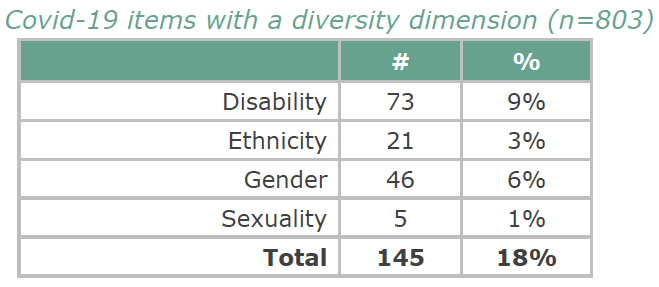
Programme participants are defined as all those who appeared or spoke within an item, excluding the programme presenters. The gender ratio was broken down in three ways: the number of participants appearing across all items, the number of unique contributors across the items (i.e. excluding repeat appearances); and the number of unique contributors when short, and often anonymous, vox-pops are excluded. In each breakdown, a broad gender ratio of 60 percent male and 40 percent female was evident.
For example, looking at appearances across the individual programmes, male participants outnumbered females in all cases. Claire Byrne Live and Ireland on Call came closest to gender parity with females representing 46 percent of participants on each programme. The 60:40 gender split in favour of males was broadly reflected on Today, Brendan O’Connor and The Late Late Show while The Business had the widest disparity with females representing 36 percent of participants.
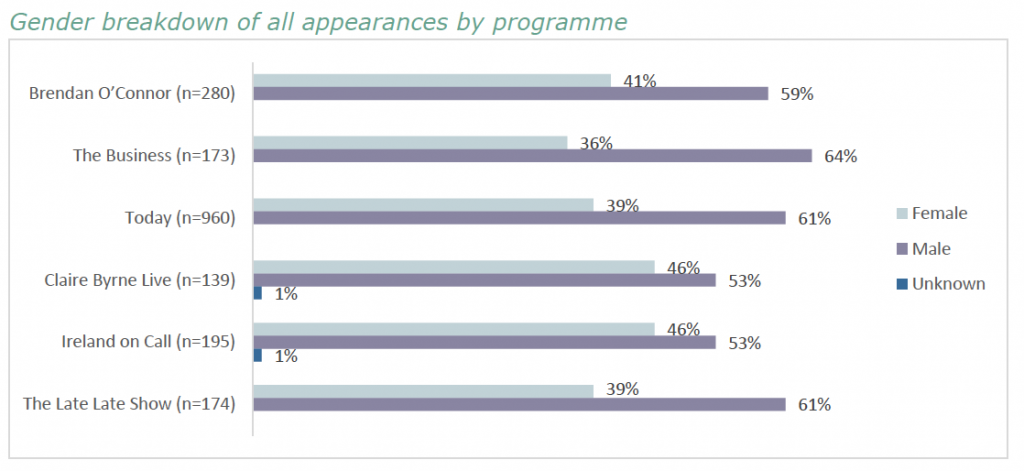
The broad 60:40 gender split is perhaps surprising given the constraints of Covid-19 and the fact that international studies found that women were squeezed out of coverage. By way of comparison, the results of the Global Media Monitoring Project examined the representation of women across news media in the UK and Ireland in September 2020. It found that women accounted for only 29% of all news sources and subjects.
Regarding panels, or items featuring more than one participant, the majority (69%) included both males and females. This was true for all programmes. However, some programmes - notably, the Brendan O’Connor programme - frequently featured large panels with five males and only one female. In general, all-male items (21%) were more common than all-female items (10%).

Using the categories adopted by the Global Media Monitoring Project, the research examined gender roles. Across all appearances, the most common roles were personal experience, expert commentators, discussion guests, and spokespersons. Males outnumbered females in almost all programme roles. However, within the most prominent category, personal experience, the split between males and females only slightly favoured males. More notable is the difference in the expert commentator category where women accounted for only 36 percent of participants.
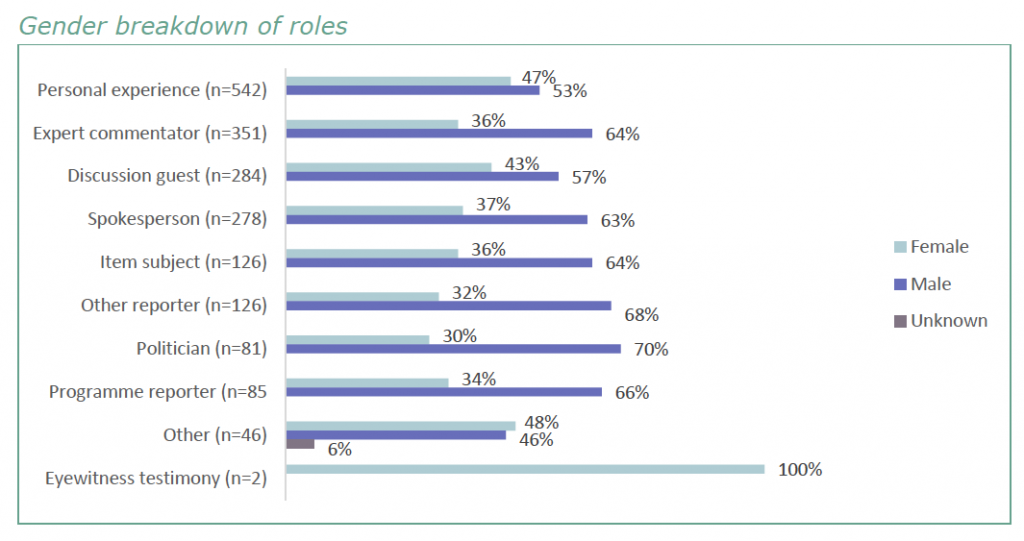
A more detailed breakdown of the content analysis is available in the report.
Interviews
Interviewees ranged from news correspondents to the head of news and current affairs and covered a range of media types - including radio, television, online - and genre types including entertainment, news, arts, and young people. The interview questions focussed on three areas: perceptions of diversity and inclusion; challenges and opportunities of Covid-19; and the future of public service media.
The interviewees articulated three arguments for why diversity and inclusion is important for RTÉ. First, they described RTÉ’s duty to reflect the changing nature of Irish society. Second, they defined a practical, business need to engage younger and more diverse audiences. Finally, they described a responsibility to champion diversity in Irish society. Almost all interviewees cited the adage “if you can't see it, you can't be it” and pointed to the lack of equal opportunities in Irish society generally and in the media sector specifically.
Overall, the interviewees articulated a nuanced understanding of diversity that emphasised social inequalities and the lack of equal opportunities to enter professions including media. On that basis, some interviewees identified class as a foundational and cross-cutting category that influences who has access to opportunities.
The interviewees outlined specific actions they had undertaken or were in the process of implementing at the time of the interviews. Overall, there was a clear emphasis on long-term and foundational actions to nurture talent from and build relationships with underrepresented communities. These types of actions were described as a bulwark against a tick-the-box or tokenistic approach to diversity.
Ultimately, increasing the diversity RTÉ’s
workforce was cited as a key goal that would drive change. Interviewees described increasing
diversity in off-air production roles as an essential part of implementing
lasting change. As one interview observed, by having different voices around
the table in research and production roles “different questions get asked”. Although
they described efforts to provide internships and training opportunities for
underrepresented groups, RTÉ’s financial situation was described as a
major obstacle to advancing diversity and inclusion. In addition, the Irish
media market was described as one where turnover of staff is limited and that
creates a constraint
Measuring diversity and inclusion
A key aim of the research was to derive insights on measuring diversity. In terms of what gets measured, it’s relatively uncontroversial to infer the gender of the people who appear in the media. But generating data about ethnicity or disability, for example, requires self-reported information. That means devising appropriate survey questions and persuading people to participate is essential. A second issue with measurement – whether it’s a survey or a content analysis – is that it can be hugely reductive. For example, a content analysis counts people and puts them into categories. That has value to obtain a broad picture, but it often erases the diversity that exists within groups and it doesn’t necessarily say anything about inclusive practices and efforts to improve diversity or how people perceive those efforts.
There’s also a wider question about how to evaluate the findings of diversity studies. Clearly access to the media and media work is tied to social inequalities and unequal opportunities: who accesses education, who enters professions, who can afford to live in Dublin, and so on. These are whole-of-society issues that extend beyond the media. In many ways, Covid-19 exemplified this problem as the majority of official roles were occupied by white middle-class men. That’s not an excuse for a lack of diversity in the media, but it does set a constraint on the media because choices about who to include are not entirely free. In the UK, the BBC’s 50/50 monitoring project makes a distinction between participants where the diversity is predetermined such as the race or gender of a government minister and participants the broadcaster is free to choose such as guests on a panel show.
Looking to the future, these issues need to be debated and discussed with all the relevant stakeholders involved. The research community has an important role to play by providing evidence to inform debates and policy, but those bigger questions about what is measured and how progress is defined and can be achieved needs to be interrogated by all stakeholders.
The research was funded through the BAI's Media Research Funding Scheme. Supporting research is one of four key areas outlined in the BAI’s Gender Action Plan to promote greater gender equality in the audio-visual sector. DCU is the Irish partner for the Global Media Monitoring Project which investigates gender diversity in news and current affairs. Earlier this year, Dawn Wheatly provided a summary of the Irish findings.
